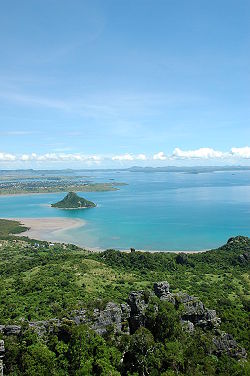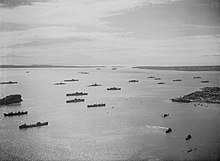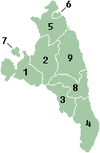Antsiranana Province
Antsiranana Province | |
|---|---|
 Antsiranana Bay | |
 Map of Madagascar with Antsiranana highlighted | |
| Coordinates: 13°35′S 49°30′E / 13.583°S 49.500°E | |
| Country | |
| Capital | Antsiranana |
| Area | |
| • Total | 43,406 km2 (16,759 sq mi) |
| Population (2001) | |
| • Total | 1,188,425 |
| • Density | 27/km2 (71/sq mi) |
| Time zone | UTC+3 |
Antsiranana is a former province of Madagascar with an area of 43,406 km2. It had a population of 1,188,425 (July 2001). Its capital was Antsiranana. A diversity of ethnic groups are found in the province, including Anjoaty, Sakalava, Antakarana, Tsimihety, Antemoro, Betsimisaraka, Antandroy, etc.[1]
History

A major battle took place at Diego-Suárez (now Antsiranana), the largest city in Antsiranana Province, in May 1942. "Fierce fighting" in the area saw over 500 Allied casualties. On May 29, Japanese submarine I-10 surfaced off the coast and launched a Nakajima A6M2-N reconnaissance aircraft over the port.
Geography
Antsiranana Province bordered Toamasina Province to the southeast and Mahajanga Province to the southwest. The province has been described as being "virtually isolated", because of Mt Tsaratanana, the highest peak, being situated in it at 2,800 metres (9,200 ft) above sea level.[2] The valleys are fertile, with tropical crops cultivated. There is a natural harbour at Antsiranana which contains a significant naval base.[2]
A large bay, known as the
Administrative divisions

Antsiranana Province was divided into two regions - Diana and Sava. These two regions became the first-level administrative divisions when the provinces were abolished in 2009. They are subdivided into nine districts:
- Diana Region
- 1. Ambanja District (Ambanja)
- 2. Ambilobe District (Ambilobe)
- 5. Antsiranana Rural
- 6. Antsiranana
- 7. Nosy Be District (Nosy Be)
- Sava Region
- 3. Andapa District (Andapa)
- 4. Antalaha District (Antalaha)
- 8. Sambava District (Sambava)
- 9. Vohemar District (Vohemar)
Economy and health
Antsiranana Province is known for its
Rural poverty is a major problem in the region, with 69.2% of the population reported to be suffering in 2001 according to reports by the International Monetary Fund.[8] An unusual percentage of children in the province have been reported to be suffering from anemia, as high as 70% in some parts.[9]
References
- ^ ISBN 978-1-139-51012-7.
- ^ ISBN 978-1-85743-131-5.
- ^ a b Rossi, G. (1974). "Morphologie et Evolution d'un karst en milieu tropical. L'Ankarana (Extreme Nord de Madagascar)". Mémoires et Documents Centre National de la Recherche Scientifique. 15: 279–298.
- ^ "Crowned Lemur". BBC. Retrieved 18 September 2014.
- ISBN 978-90-04-21181-0.
- ISBN 978-1-4426-0374-5.
- ISBN 978-0-520-93588-4.
- ^ Madagascar: Poverty Reduction Strategy Paper. International Monetary Fund. 2003. p. 20.
- ISBN 978-0-8213-8538-8.
